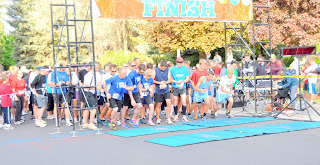The job of the calf muscle is to move the foot into the pointed toes position (also called plantar flexion). Most of its daily work is done in cooperation with the hamstring to push the ground away as you walk.
A good yoga practice balances body, mind, and spirit, uniting the three aspects of ourselves to create harmony and peace. A yogic approach to creating flexibility in the calf necessitates attention to the muscles that work with the calf to lengthening and strengthening the whole system.
There are many yoga postures that can help bring flexibility to the calf and awareness to the feet.
Here is my favorite place to start bringing awareness to the range of motion of the ankle. From a comfortable seated position:
- Hold on to the lower right leg with the right hand, lifting the foot off the ground.
- Spread the toes of the foot as far apart as possible
- Place the fingers of the left hand into the spaces between the toes,
- Holding the right foot in the left hand with the left fingers intertwined in the right toes, use the left hand to circle the right foot in both directions
- Repeat with the other hand and foot

- Stand tall and straight and feel yourself anchoring to the support of the earth through the four corners of the feet.
- To get a sense of the four corners lift and spread the toes, laying them down starting the pinkie and maintaining as much space between them as possible.
- With the corners of the feet grounded feel the support and energy rebound up the center of your legs, entering the body right through the center of the arch. The rebound energy lifts the knee caps, engages the quads, pulls the belly into the spine, points the tailbone to ground.
 The yoga posture that most directly brings length to the calf muscles is Paschimottanasana—sitting on the ground with the legs out straight and the toes pulled in toward the heart, using hands or strap resist the natural urge for the feet to point forward. Paschimottanasana also lengthens the hamstring.
The yoga posture that most directly brings length to the calf muscles is Paschimottanasana—sitting on the ground with the legs out straight and the toes pulled in toward the heart, using hands or strap resist the natural urge for the feet to point forward. Paschimottanasana also lengthens the hamstring.
A good counter stretch to paschimottasana is Hero (virasana)—sitting on the heels or with the feet by the hips knees bent—provides a stretch across the front/top of the foot and provides gentle strengthening to the back of the leg.
All of the standing postures are good for the feet and the core muscles. Practicing many different standing poses will give all of the muscles of the lower leg the chance to contract/strengthen and stretch/lengthen, increasing flexibility all around. Since we’re most interested in increasing flexibility, here’s what’s lengthening*** in the lower legs and feet:
- Uttanasana (forward fold)—lengthen calf and hamstrings
- Prasarita Padottanasana (wide angle forward fold)—lengthens the back legs and the outside ankle
- Utkatasana (chair/fierce)—gently lengthens the calf muscles
- Trikonasana (triangle)— lengthen calf and hamstring of back leg
- Virabhadrasana II (warrior II)— lengthen calf and ankle side of back leg
- Parsvotanasana (pyramid)— lengthen muscles on shin of the front leg and into toes, sole of back foot lengthens with the calf and hamstring
- Virabhadrasna I (warrior I)— lengthen back calf and sole
- Parivrtta Trikonasana (revolved triangle)— lengthen top of front foot and inner ankle; back calf, sole, and outer ankle lengthen
- Down dog(ahdo mukha svanasana) lengthens the calf muscles as the heels press toward the ground
Another yoga teacher’s perspective can be found on youtube.
I hope that becoming more aware of the movement and energy of your feet is beneficial to you.
Disclaimer: I am a yoga teacher attempting to apply my training to a problem raised by one of my student friends. I have no medical training and do not mean to suggest or imply that any advice or suggestion offered here has any merit beyond yoga practice.
* http://www.ncbi.nlm.nih.gov/pmc/articles/PMC2848339/ “Muscle imbalance and inflexibility, especially tightness of the triceps surae (gastrocnemius, soleus, and plantaris muscles), is commonly associated with MTSS [1, 7, 8].”
** http://www.ncbi.nlm.nih.gov/pmc/articles/PMC2848339/ Weakness of “core muscles” is an important risk factor for lower extremity injuries [16, 19–21]. Hip and pelvis muscle strength are an important link in maintaining control and proper mechanics between the “core” and lower extremity [16, 22].
***Muscles always work in pairs, if one lengthens another strengthens.










